
Hiking Dude Blog
2025 2024 2023
2022 - Nov Oct Sep Aug
2021 2020 2019 2018 2017 2016 2015 2014 2013 2012 2011
10/31/2022

How well do you eat on the trail?
Are you a Grazer, nibbling on bits of snacks from a bag as you hike along all day? Or, a Three Square Meals kind of guy, taking the time to prepare a real breakfast, lunch, and dinner each day? Most likely, you're somewhere in between with a quick, hot breakfast, simple lunch, snacks through the day, and finishing with a cooked meal at camp.
For the past ten years, I've mostly been a Grazer, not wanting to sacrifice miles to stop and make meals. I tend to keep moving as long as the sun is up. Now that my wife has joined me, we've decided to take the time to heat water for coffee or cocoa in the morning and make hot meals for dinner. I must admit that taking the extra time is definitely worth the couple miles of trail missed.
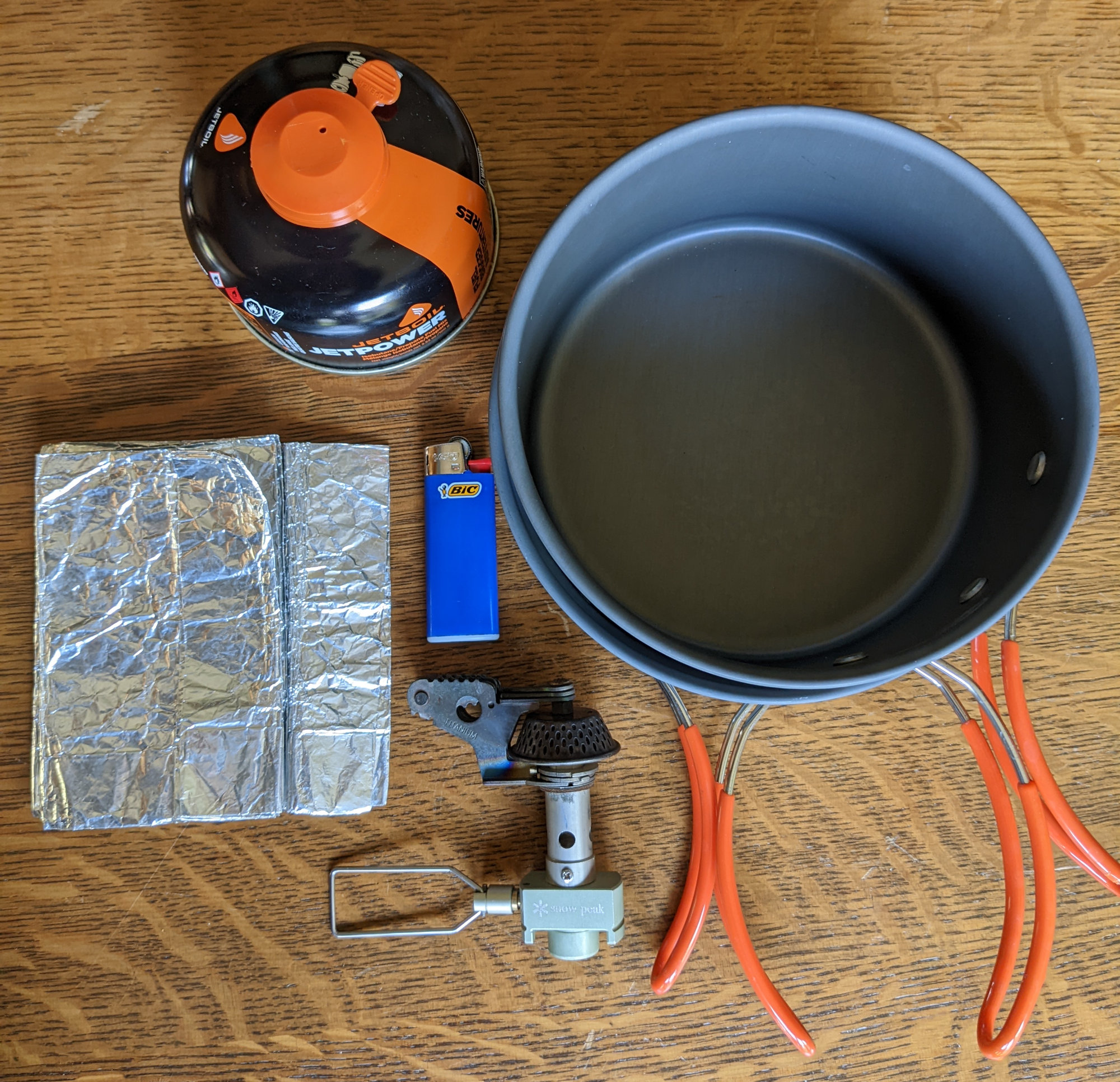
Resigned to the extra effort of carrying the food, stove, fuel, and cook kit, I still want to be as efficient as possible with our food system. So, I came up with these goals to meet with whatever meals we decide to use:
- hot meals - this rules out no-cook and cold-soak styles. We want the warm feeling of hot food.
- variety of flavors - not the same meal day after day. One big bag of ramen noodles isn't good enough.
- healthy - use minimally processed ingredients as much as possible.
- minimize cooking effort and time - we'd like to be able to prep, eat, and clean up in 30 minutes or less.
- minimize trash and clean-up - this mostly means we'd like to only boil water in our pot and eat the food out of the bag it is cooked in.
- minimize fuel use - long simmering times kill fuel. Just quickly heat water and rehydrate is better.
- minimize cost - prepackaged meals are easy, but expensive.
- minimize chemicals, preservatives, and packaging - simply dried ingredients rather than highly salted and chemically preserved would be better.
- minimize carried food weight - the higher calories per ounce, the better.
Just Buy Them
It's easy to purchase meals from Alpine Aire, Backpacker's Pantry, Good To Go, Mountain House, Peak Refuel, RightOnTrek, and other brands. You get hot meals quickly with little trash. Unfortunately, there is often a lot of salt and chemicals, the flavor is defined for you, and the cost is high.
Researching a few brands showed that Mountain House averages about 43 calories/$1.00 and 122 calories/oz. while Good To Go averages about 50 calories/$1.00 and 107 calories/oz. The others are in the general ballpark.
We hoped to do better.
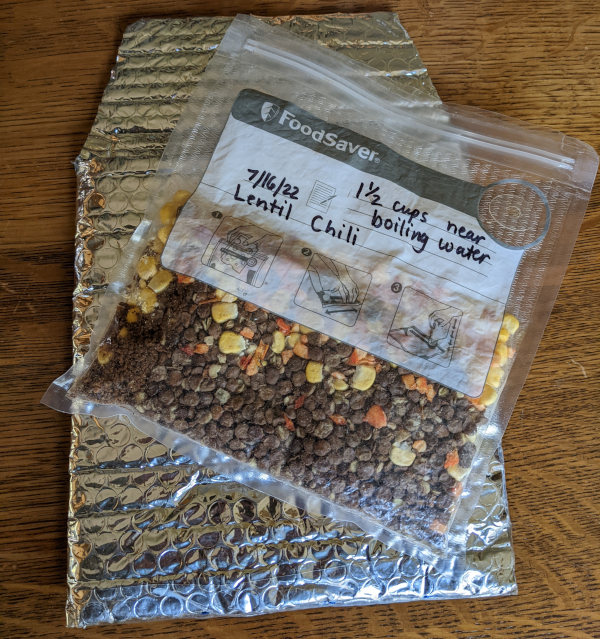
MYOM - Make Your Own Meals
To save cost, get a custom fitted item, and have a sense of accomplishment, some hikers do MYOG (Make Your Own Gear). I've made quilts, shelters, packs, and other things. It's great.
For the same reasons of saving cost and getting the exact food we want, we decided to Make our Own Meals. A meal typically includes a carbohydrate base, protein source, vegetables, and spices. It turns out that a lot of the ingredients can be easily found at regular grocery stores, but dried and freeze-dried items can be bought online in bulk for less cost.
After checking out quite a few freeze-dried sources, I settled on Mother Earth Products as the best spot with a wider range of product at a lower price than others. We've now made nearly 100 meals using their ingredients and are very pleased with the results.
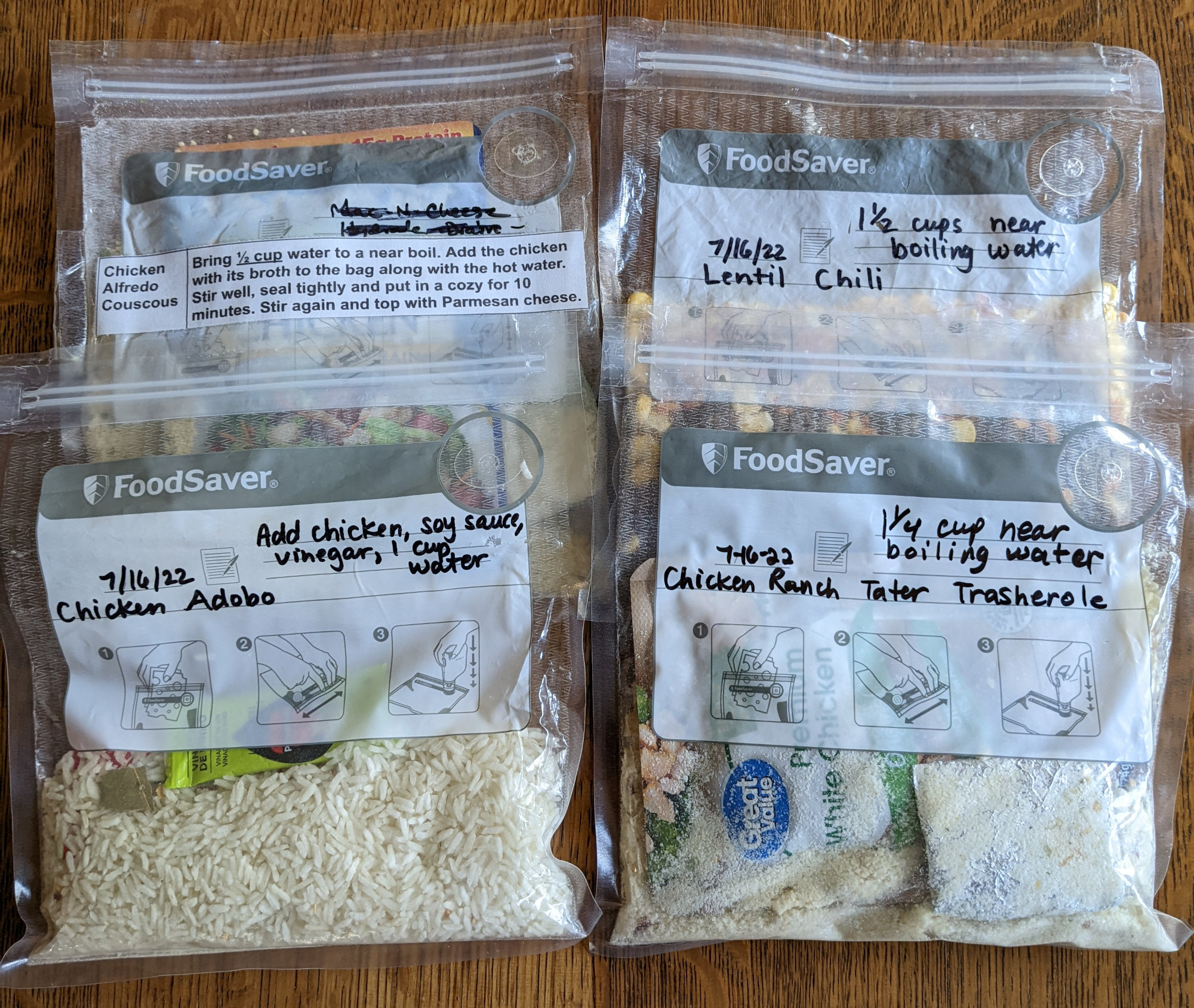
Creating a Meal
I believe a MEAL needs to provide nutrition and calories, taste good, and fill my stomache. A bowl of rice might fill me up, but doesn't provide much nutrition or taste. So, with a broad selection of ingredients, it's up to you to combine them into meals that sound good to you. Here's how we did it: (and all of these are dried or freeze-dried items)
- Start with a BASE. This gives the general texture and form to the meal, and is typically a carbohydrate.
- instant rice
- ramen noodles
- mashed potatoes
- couscous
- lentils
- refried beans
- split peas
- stuffing mix
- Add a PROTEIN. Drying cooked ground beef works well, but we are using textured plant-based protein. The main plant protein sources are soy, wheat, or pea - we used soy. Mother Earth offers protein crumbles in various flavors:
- taco
- beef
- chicken
- unflavored
- Add VEGETABLES. Here is where you start setting the color and look of the meal, as well as flavor
- corn
- peas
- bell peppers
- onions
- carrots
- mushrooms
- black beans
- Add SPICE. Make things as bland or snappy as you like. Maybe just salt and pepper in a potato, chicken, corn, and pea meal, but plenty of taco seasoning in a ramen, beef, bell pepper soup. Absolutely anything out of your spice rack is fair game, including garlic, cumin, chili powder, cayenne pepper, dry ranch dressing, and so on.
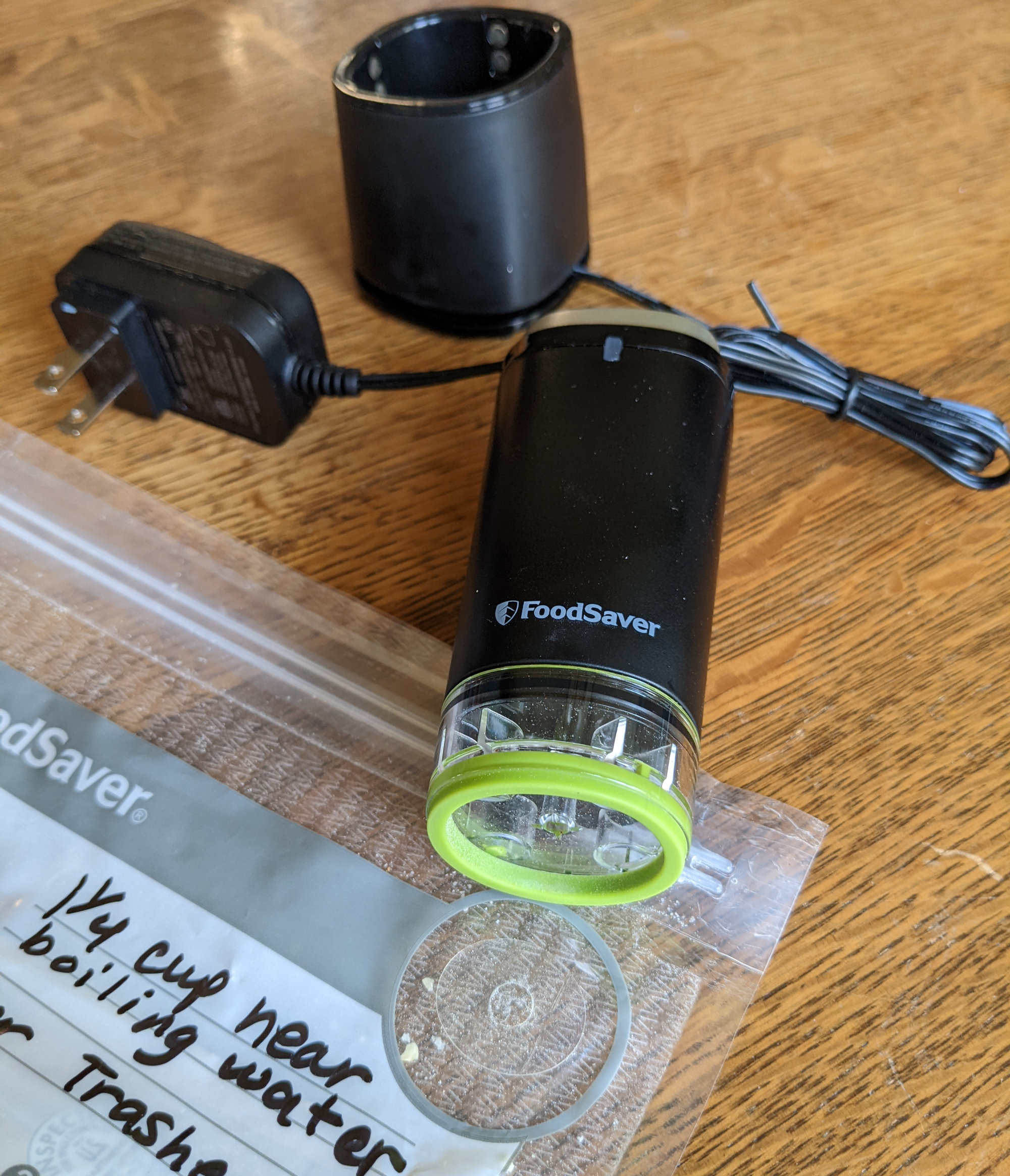
Assembly and Packaging
When combining the ingredients, it may not look like enough for a meal since everything is dry. When hot water is added, you might be surprised at how filling that tiny, light bit of food becomes.
So, check the calorie information and serving size for each ingredient. Typically, a serving size for freeze-dried ingredients is 1 ounce (28 grams) and the carbohydrate base is twice that much. And, in general, there are about 100 calories per ounce.
Using an accurate postal scale really helps since the volume of some items changes more than others when dried. A typical meal includes two servings of the base, one serving of protein, and a half serving or so of each vegetable.
You could pour your dry ingredients into zip-loc baggies and use them to cook in, and I bet it would work fine. But, my wife found this very cool Foodsaver vacuum device. It is soooo fun!
Ingredients get placed in special zip-loc bags that also have a vacuum circle. After sealing the zip-loc part, the device is pressed on the circle and it sucks out all the air and lets none back in. So cool!
This reduces the space each bag takes up and it must help with storage time by removing the oxygen and whateve moisture is in the extra air. Even using a sealing device like this, I wouldn't assemble meals more than a month before using them. Once dried items are removed from their sealed manufacturer's container they start degrading.
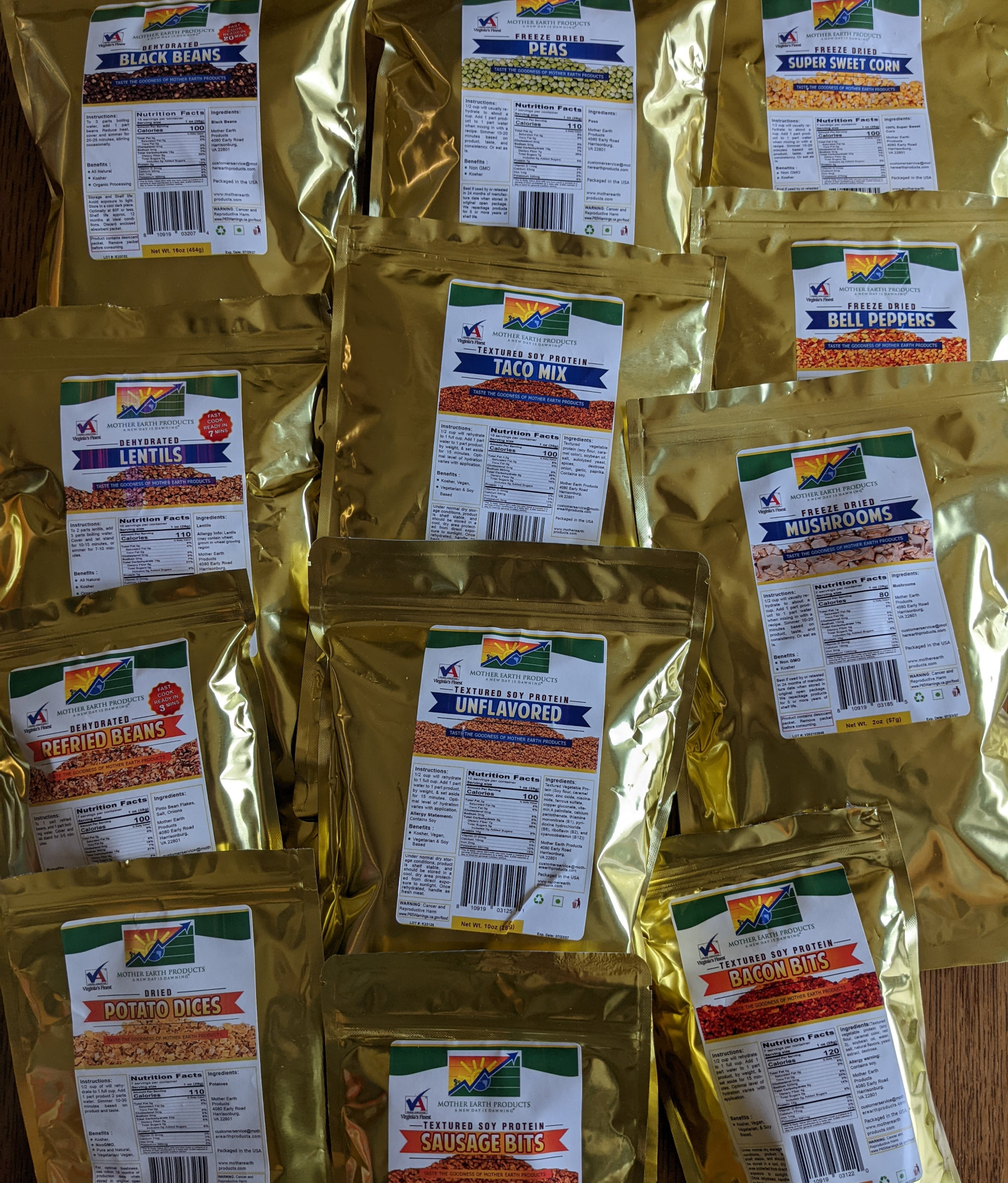
Instructions
- Measure individual ingredients
- Pour ingredient into foodsaver bag
- Add any required single-serving packs needed (soy sauce, chicken, tuna, ...)
- Seal the zip-loc strip
- Vacuum out the air
- Put a piece of packing tape on bag, write the meal name, amount of water needed, and any other instructions on the tape
- Put another piece of tape over the writing so it doesn't smear
How Much Fuel?
Well, it doesn't get much easier than boiling water, but we can be efficient about even that simple task.
Each meal needs about 1.25 cups of water, but some are more or less.
Your stove needs a certain amount of fuel to boil 1 cup of water. You really should know what that is before heading out on an adventure.
Figure out how much fuel you need to carry from:
- How many ounces of fuel (F) are needed to boil a cup of water on your stove?
- How many people (P) are in your group?
- How many days (D) will you be on trail cooking?
- How many cups (C) of water need to be boiled for a meal? (typically 1.25 cups)
Ounces of Fuel Needed = F * P * D * C
This is fuel needed only for these meals. You may need more to heat water for breakfasts, washing, and whatever other needs you have.
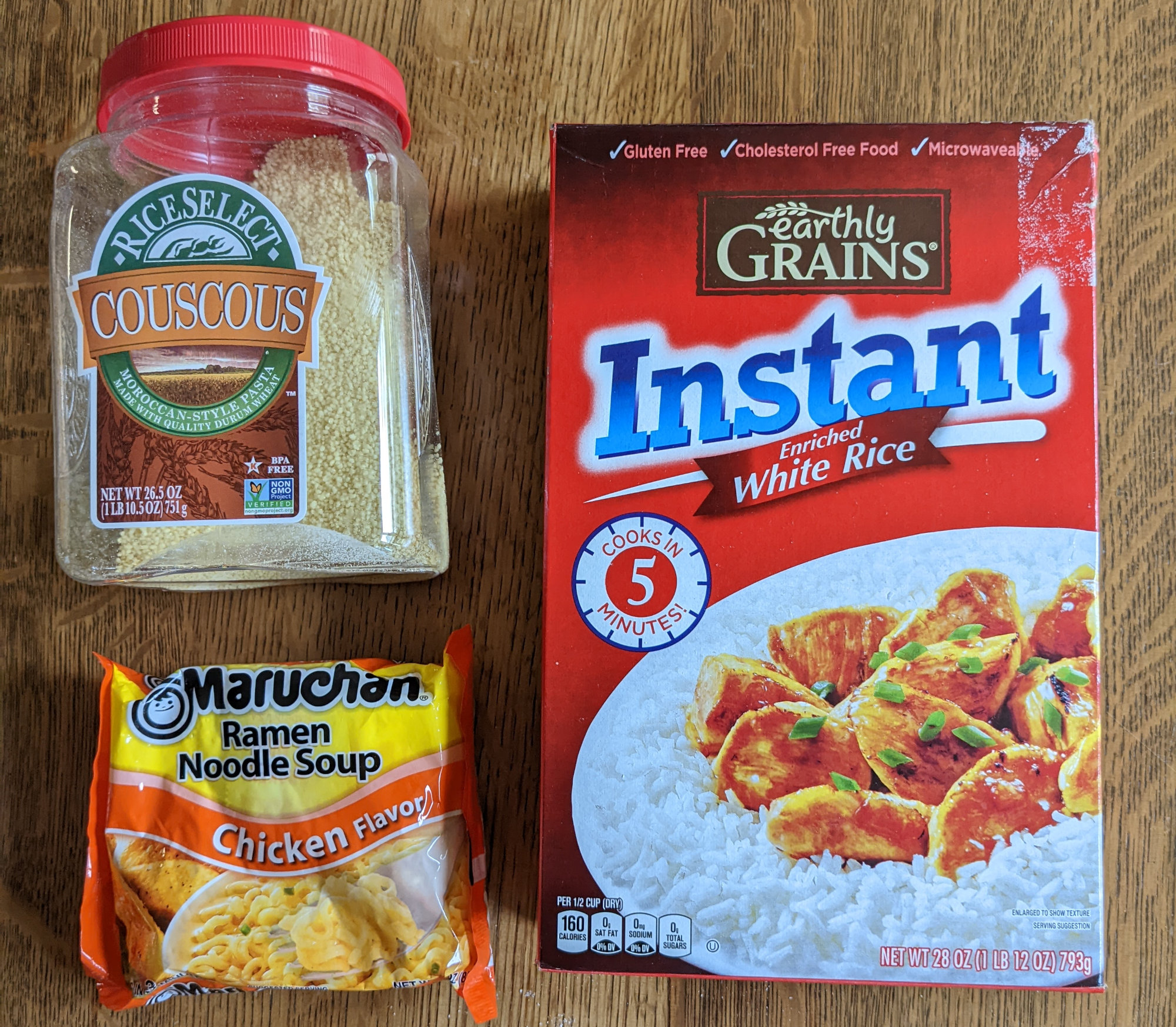
Cooking
The real beauty of these meals the filling flavor you get with minimal cooking effort. It takes less than 30 minutes from opening your backpack to eating hot food.
- Set up your stove - anything from a tiny alcohol popcan stove to a two-burner propane stove works just since we're just heating water.
- Measure the appropriate amount of water into your cook pot. You can scratch measurement lines into your metal pot, or mark them on a water bottle, to eliminate the need for another container.
- Light the stove and place your pot of water on top, with a lid on it.
- While the water is heating, open any single serving packets in your meal bad and dump their contents into the bag.
- Set your meal bag in your cozy.
- If you are using potable, treated water, it's ready as soon as small bubbles rise from the bottom. If you use raw water, wait until it is a full, rolling boil, but there's no need to boil it for minutes.
- Pour the appropriate water into your food bag.
- Remove most of the air as you seal the bag's zip-loc.
- Shake, massage, stir, or knead the bag to mix the water well.
- Close the bag inside your cozy and wait. Place multiple cozies close together to retain heat. Wrap cozies in another insulating layer such as a fleece or t-shirt if the air temperature is cold. If you are cooking for 2 or 3 people, consider making a cozy that is a bit larger to hold 3 meal bags to really eliminate heat loss and reduce weight.
- Shake the cozies at about 5 minutes, and again at 10 minutes.
- By 15 minutes, the food should be completely rehydrated and still very hot. Eat it right out of the bag in the cozy so it stays warmer longer.
If you prefer, you can heat water, then dump ingredients from a meal bag into your pot, stir and simmer. This creates dishwashing, but you might prefer eating out of pot instead of bag. You can have individual bowls to serve the meal into if that sounds more civilized than eating out of a bag or pot, and you don't mind the extra cleaning.
To reduce weight even more, but also reduce flexibility, using a larger meal bag to hold 3 servings can work. All 3 people are forced to eat the same meal, but you have fewer plastic bags and more efficient heating. You'll want to have individual bowls to serve into if you do this.
Reusing
We've found these Foodsaver vacuum bags to be very sturdy and use them over and over.
- After eating, pour a little more warm water into the meal bag, swish it around, and drink it to clean out nearly all the food bits. Think of this as a second soup course.
- Roll the bag up and seal it closed.
- Keep all your dirty bags in a rolled up bundle with a rubber band and place that inside a quart sized zip-loc baggie to isolate it.
- Back at home, remove the taped on label, wash and dry the bags for the next use.
Limitations
This system works great on treks where you can carry all your food from the start. This would be any backpacking or long hike up to about 2 weeks. Longer than that, and people tend to resupply along the way. Then, what to do with the used bags is a challenge, with the food bits decaying inside them.
A Few Recipes
It's very easy to put together ingredients in whatever combinations sound good to you, but here are a few examples of meals that we've enjoyed. All the freeze-dried and TVP items were purchased from Mother Earth Products.
Just add about 1 1/4 cup hot water to each one.
Lentil Chili
- 2/3 C freeze-dried Lentils
- 1/2 C TVP Beef Crumbles
- 1/4 C freeze-dried Corn
- 1/4 C freeze-dried Peas
- 1 Tbsp Chili Seasoning
Chicken Curry Rice
- 1 C Instant Rice
- 1/2 C TVP Chicken crumbles
- 2 Tbsp Golden Raisins
- 2 Tbsp crushed dried Apples
- 2 tsp dried Onion
- 1 tsp Butter Powder
- 1 tsp Curry Powder
- 1/8 tsp ground Allspice
- 1/8 tsp ground Cinnamon
- 2 Tbsp crushed walnuts
Healthy Bowl
- 3/4 C Instant Rice
- 1/4 C freeze-dried Lentils
- 1/4 C diced Almonds
- 1/4 C dried Cranberries
- 1 tsp vegetable boullion
- 1/4 tsp tumeric powder
- 1 pinch salt
Pesto Veggie Pasta
- 1 pkg ramen noodles (not spices)
- 1/2 C TVP
- 1 Tbsp dry Pesto mix
- 2 Tbsp dried mushrooms
- 1/4 C dry, grated parmesan cheese
- 1/4 C freeze-dried mixed vegetables
10/11/2022

With my new multi-day hiking partner (my wife) preferring hot dinner meals and insisting on hot coffee in the morning, I'm resigned to carrying a stove again. That means a pot, windscreen, and fuel, too. The fuel is heavy so I want to be as efficient with it as I can.
We're just boiling water and adding it to dehydrated food, so the two points of efficiency are preventing the flame heat from escaping and then preventing the heat in the water from escaping.
A super light aluminum foil windscreen helps with the first. It prevents wind from blowing the heat away and lets it reach the water better.
To prevent lose of heat from the water, we're using new cozies. Rather than pouring the dried food into the water in the pot and letting it rehydrate while simmering for 15 minutes, a food cozy rehydrates the food and keeps it hot without using extra fuel. Plus, it means no clean up of the pot is needed. And, if you just eat out of the bags, the only dirty item is your spoon. (We take our food bags home dirty, wash them, and use them multiple times.)
Once the water is boiling, we turn off the stove, pour the hot water into the food bag that is inside the food cozy, stir it up, and let it sit for 15 minutes.
Even at near freezing temps, the rehydrated food is still too hot to eat. But, you could put the cozies together and wrap in another insulating layer such as a shirt, stocking hat, or sleeping bag - even better, hold it against your body under your clothes!
These food cozies are very easy and inexpensive to make. I've shared the steps with photos for our New, Improved Food Cozy and hope you have fun making your own.
PS: On our recent Border Route Trail hike, we took two 100 gram canisters and had about 35 grams left in one at the end. I think we used more fuel than necessary, so I'm working on a better windscreen design. Also, one larger canister has a better fuel to packaging ratio and that would save some pack weight.
Hike On!
Posted: 10/11/2022
10/07/2022
Anyway, it was a great trip with a lot of solitude in the first half and lots of people the second half.
Please read my Border Route Trail Info page, or jump right to the BRT Journal page.
Hike On!
Posted: 10/07/2022
09/28/2022
Posted: 09/28/2022
09/22/2022
Posted: 09/22/2022
09/20/2022
I find the few days right before a backpacking trip to be very exciting. Trying to make sure I have everything I really need, but not extra weight I don't need on this trip. Wondering if I really have enough food, or if I should add another handful of Sour Patch Kids. Checking that I can actually access the maps I think I downloaded to my phone even when it's in airplane mode. And, on and on.
Tomorrow, we'll be Up North to hike our 100 miles on the North Country Trail for 2022 and get a patch! We're going to hike the Border Route Trail from the west trailhead on Gunflint Trail road to the east trailhead on Otter Lake Road. This hike is about 65 miles and just happens to end right where the Superior Hiking Trail starts. Isn't that convenient?
Instead of stopping there, we're going to hike about another 50 miles down the SHT to Grand Marais, MN. That way, we can hop in our car and drive home at whatever time on whatever day we happen to finish without needing a shuttle at the end.
Most of the first 4 days will be in the Boundary Waters wilderness with no phone coverage, but I'll have my Spot along. If you'd like to make sure we're still moving, check out this real-time map - I hope it works. Once we hit the SHT, I might be able to drop a note now and then, but we'll see.We were planning on doing this last week, but starting into a 100% chance of rain for 2 days seemed kind of silly. The forecast is looking much better now and the fall colors should be well under way. And, there's a group of people I know doing a SHT thru-hike NorthBound that will be close to Grand Marais when we get there. If things fall into place, we might find them on trail to say 'Hi'.
Our packs with 10 days of food and expected temps right down to freezing are just about 30 pounds so I'm excited to start eating some of that weight off. When we finish, I'll tell you more about the new dinner meals we've been making and enjoying this season. So far, they've been most excellent!
Posted: 09/20/2022
Older Posts Newer Posts
Find more Hiking Resources at www.HikingDude.com


Follow Me
Recent Comments